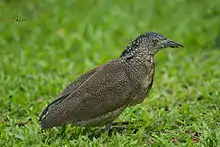Malayan night heron
The Malayan night heron (Gorsachius melanolophus), also known as Malaysian night heron and tiger bittern,[2] is a medium-sized heron. It is distributed in southern and eastern Asia.
| Malayan night heron | |
|---|---|
.jpg.webp) | |
| Scientific classification | |
| Domain: | Eukaryota |
| Kingdom: | Animalia |
| Phylum: | Chordata |
| Clade: | Dinosauria |
| Class: | Aves |
| Order: | Pelecaniformes |
| Family: | Ardeidae |
| Genus: | Gorsachius |
| Species: | G. melanolophus |
| Binomial name | |
| Gorsachius melanolophus (Raffles, 1822) | |
 | |
| Range of G. melanolophus Breeding range Resident range Wintering range | |
Distribution and habitat
The Malayan night heron has been found in India, Sri Lanka, Brunei, Nepal, Bangladesh, Myanmar, Cambodia, Laos, Vietnam, Thailand, Malaysia, Singapore, China, Indonesia, the Philippines, Taiwan and Japan. It is a vagrant in Christmas Island and Palau.[1] Its range size is estimated at 1,240,000 km2.[1] This bird occurs in forests, streams, and marshes.[3]
Description

The Malayan night heron is about 48 cm (19 in) long.[4] The wingspan is about 86 cm (34 in).[5] It is stocky, with a short beak. Its neck and breast are rufous. There are streaks going down the centre of the neck to the breast.[4] The upperparts are chestnut and vermiculated. The flight feathers are blackish.[4] The crown is black, the chin is white, and the eyes are yellow.[6] The beak is black and the legs are greenish.[5] The juvenile is greyish to rufous and is spotted and vermiculated.[3]


Biology
The Malayan night heron is usually solitary. It roosts in trees and feeds in open areas.[4] Its territorial call is deep oo notes.[4] It also produces hoarse croaks and arh, arh, arh.[6] The most common food items are earthworms and frogs, and it will sometimes eat fish.[7] A study of its pellets found reptiles, snails, chilopods, arachnids, crabs and insects.[8]
Conservation
The bird has a large range and its global population is between 2,000 and 20,000 individuals. Its population trend is not known, but it does not meet the criteria for a vulnerable species status.[1]
References
- BirdLife International (2016). "Gorsachius melanolophus". IUCN Red List of Threatened Species. 2016: e.T22697242A93604480. doi:10.2305/IUCN.UK.2016-3.RLTS.T22697242A93604480.en. Retrieved 12 November 2021.
- "Malayan Night-Heron". Birding in Taiwan. Retrieved 31 July 2016.
- Grimmett, Richard; Inskipp, Carol; Inskipp, Tim (2013). Birds of the Indian Subcontinent. Bloomsbury. p. 82. ISBN 978-1-4081-6264-4.
- Jeyarajasingam, Allen; Pearson, Alan (2012). A Field Guide to the Birds of Peninsular Malaysia and Singapore. Oxford University Press. p. 99. ISBN 978-0-1996-3942-7.
- Kennedy, Robert (2000). A Guide to the Birds of the Philippines. Oxford University Press. p. 31. ISBN 978-0-1985-4668-9.
- MacKinnon, John; Phillipps, Karen (2000). A Field Guide to the Birds of China. Oxford University Press. p. 236. ISBN 978-0-1985-4940-6.
- Chang, C. (2000). Malayan Night Heron Gorsachius melanolophus breeding in immature plumage. Forktail 16 167–8. Downloaded on 26 August 2010.
- Kawakami, Kazuto; Fujita, Masaki; Hasegawa, Motohiro; Makahira, Hiroshi (2011). "Dietary characteristics of the Malayan Night Heron (Gorsachius melanolophus) in the Yaeyama Islands, southern Japan". Chinese Birds. 2 (2): 87–93. doi:10.5122/cbirds.2011.0015.
